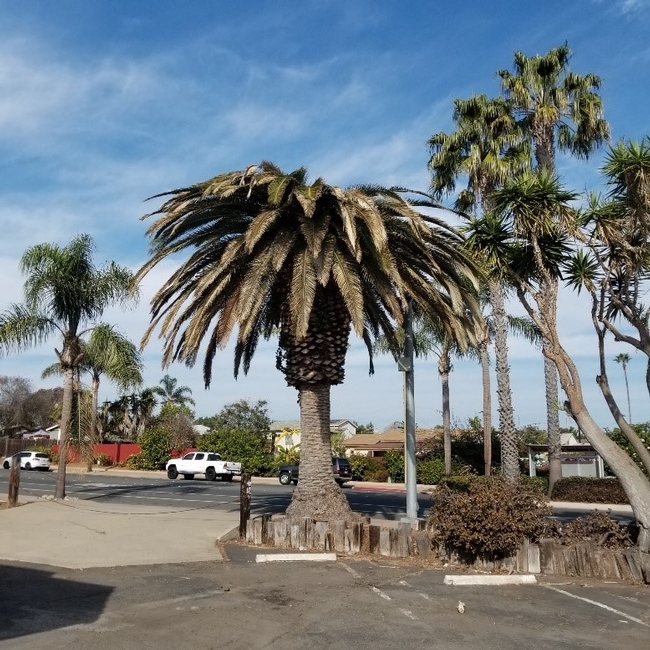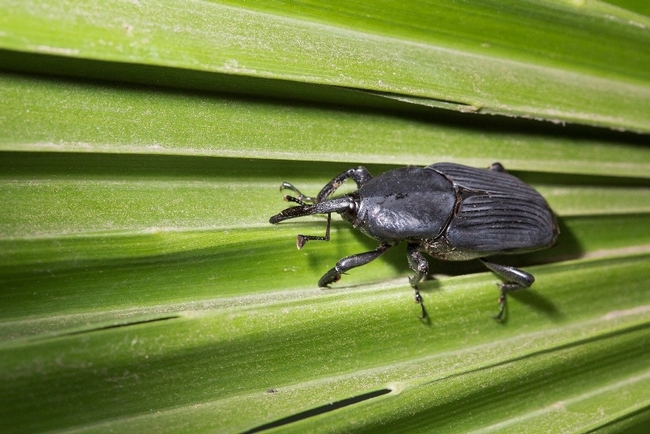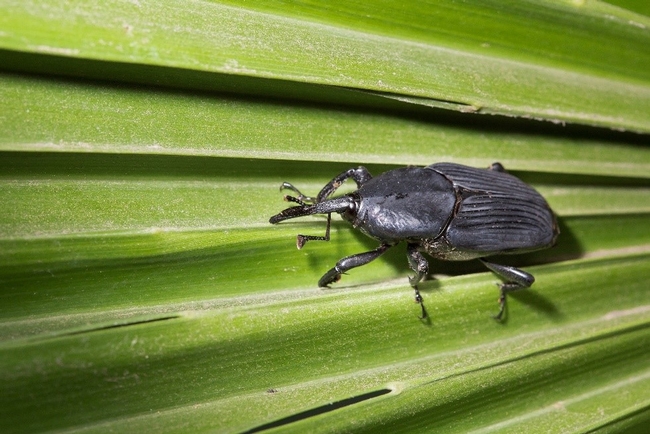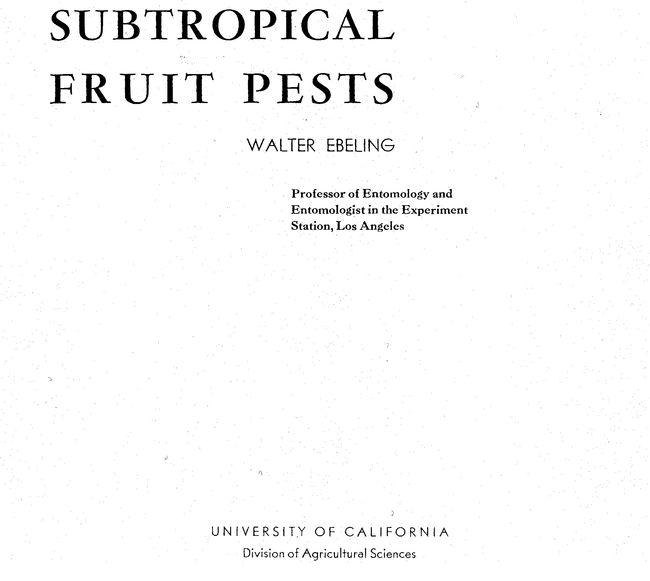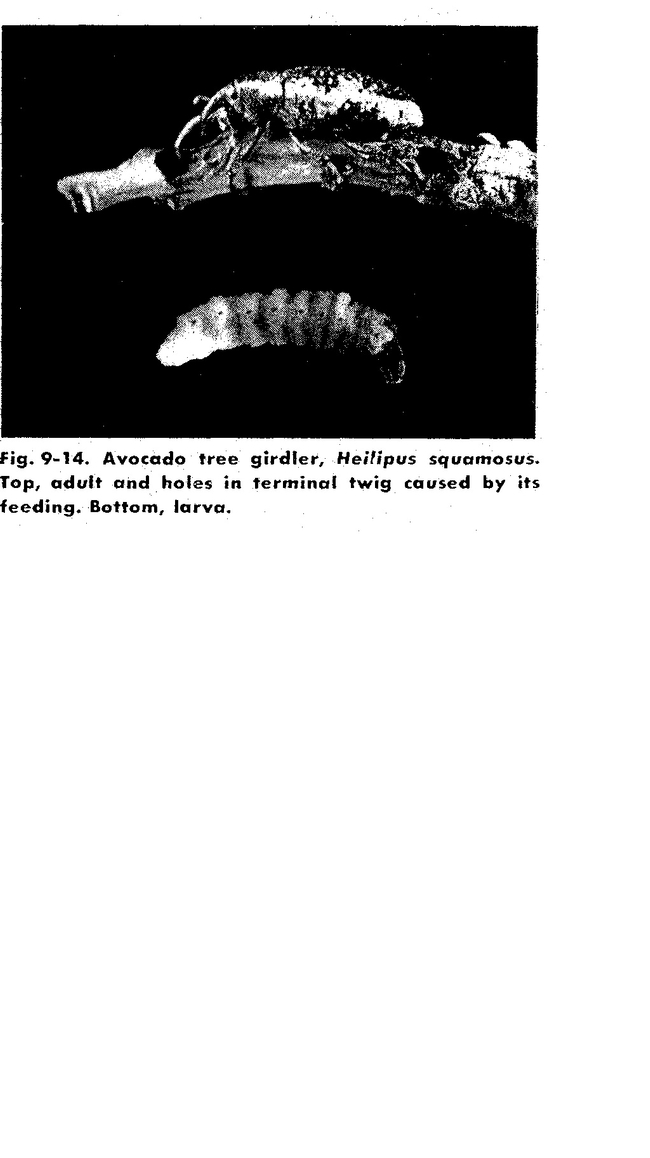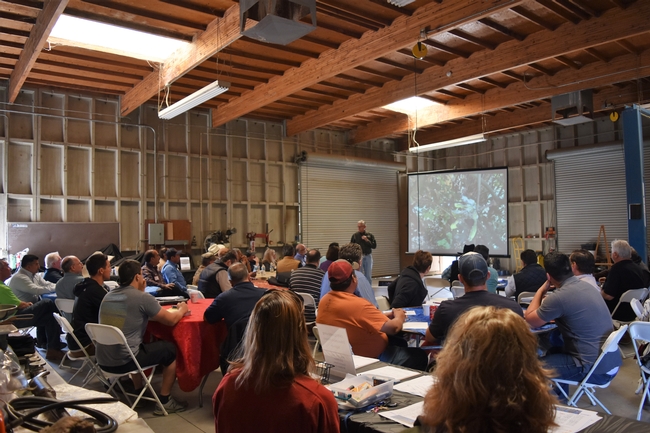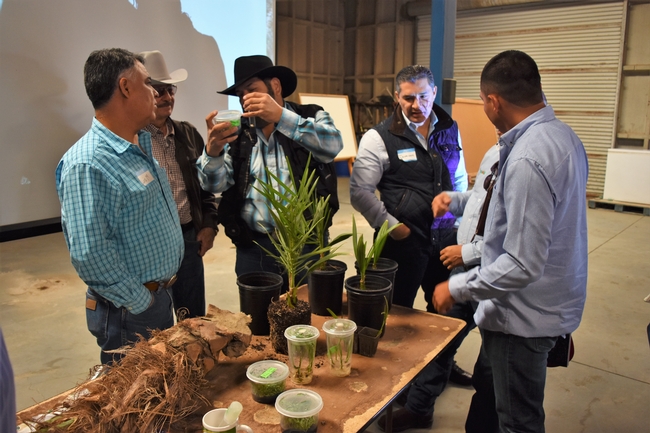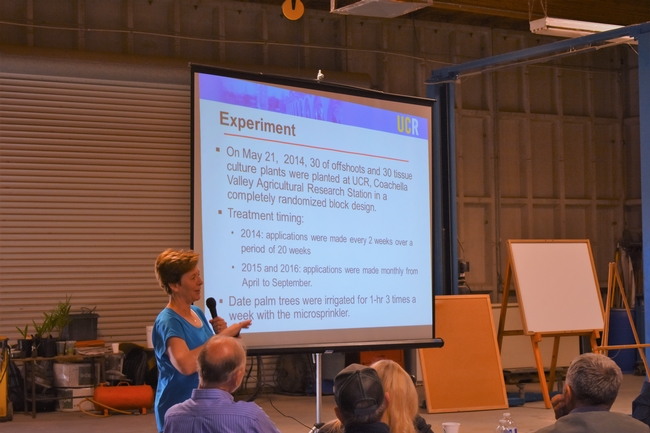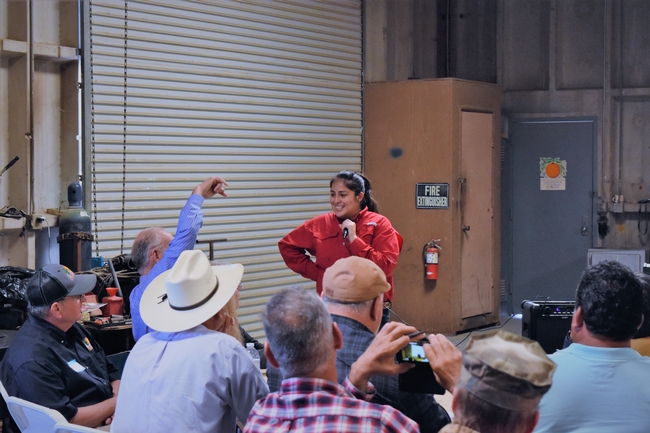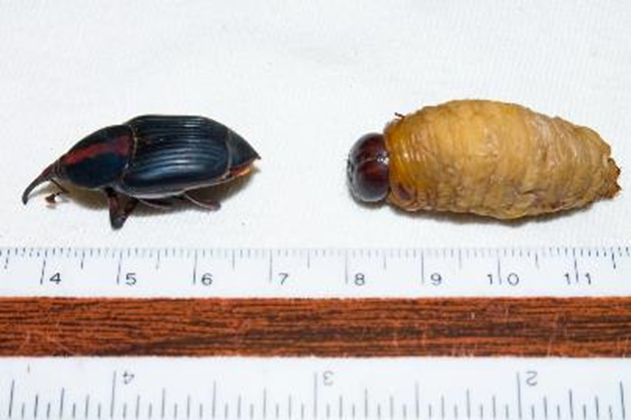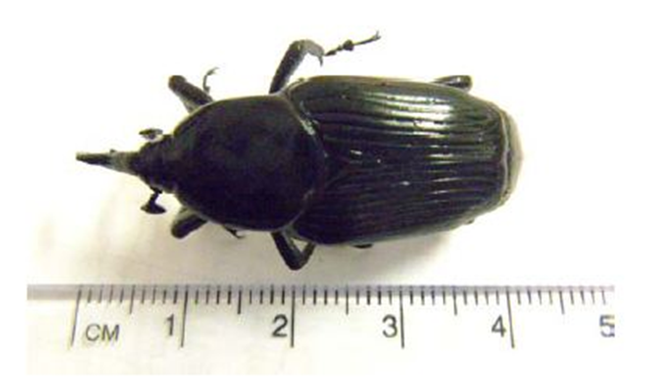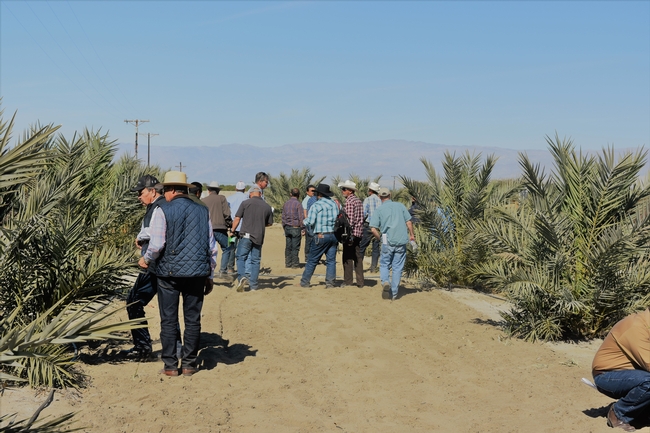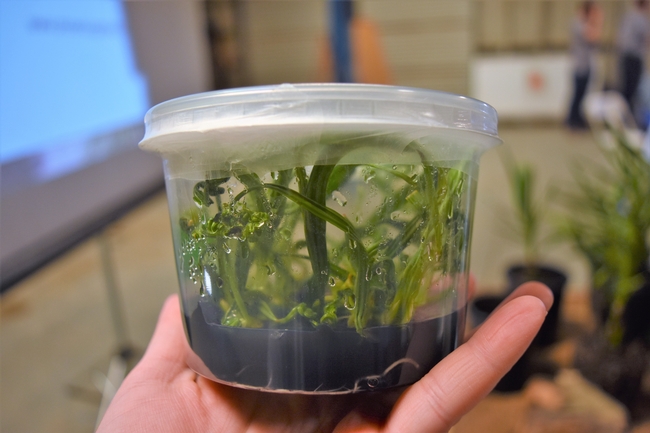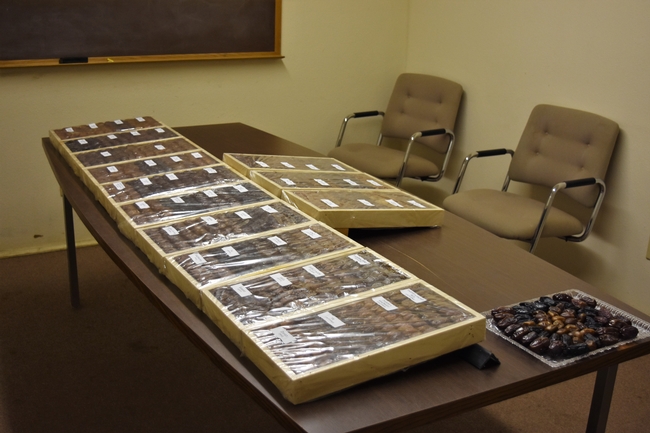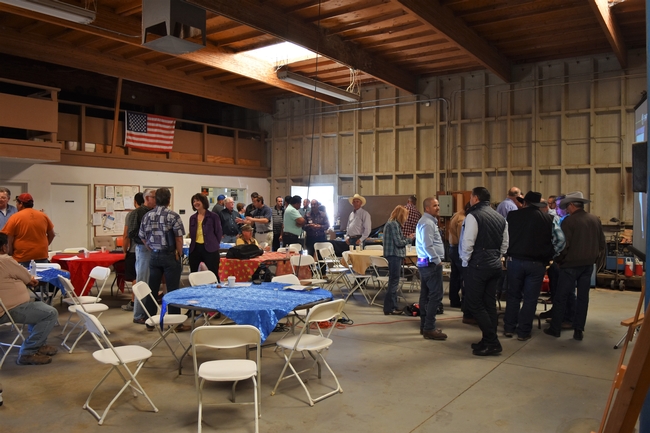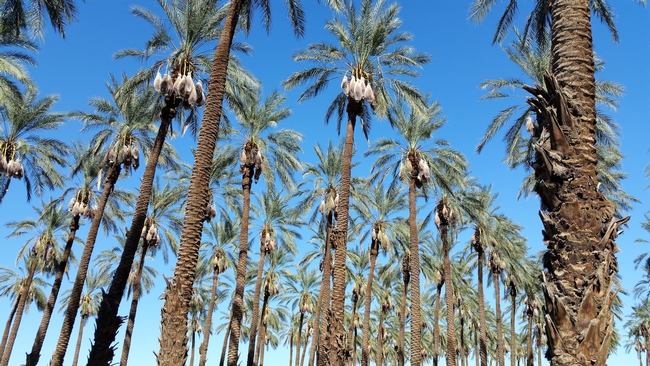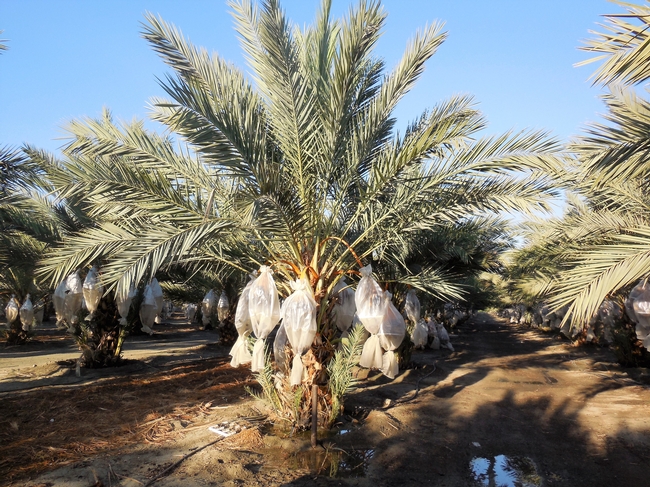
Posts Tagged: date
Palm Weevil Threat to Palm Trees
Date growers in the California deserts have many insects to worry about such as carob moth, hibiscus mealybug, and giant palm borer. Now the industry is under threat from another potential pest, the highly damaging and invasive South American palm weevil (SAPW) (Rhynchophorus palmarum). It was first identified by county and state agriculture officials in 2011 in San Ysidro in San Diego. They made the discovery while looking for a closely related palm weevil, R. vulneratus (originally mis-identified as the notorious red palm weevil, R. ferrugineus), which was found in Laguna Beach and declared eradicated in Jan. 2015.SAPW has been reported on at least 35 plant species in 12 families and is especially economically important on plantation crops such as oil and ornamental palms of which date palm, Phoenix dactylifera, is a recorded host (CABI 2016; Dean 1979; Esser and Meredith 1987). SAPW has killed hundreds of Canary Island date palms (P. canariensis) in Tijuana and parts of San Diego County. These large urban infestations pose a significant risk to the multi-million dollar date palm industries (edible fruit and ornamentals) in the Coachella Valley. Losses of ornamental Canary Island date palms in San Diego County, are probably significant and likely now reaching millions of dollars in killed palms, reduced aesthetics, and increase removal costs.
SAPW has a long rostrum (this is the beetle's snout) and is large often up to 1 ½ inches to 2 inches in length (CDFA 2018). SAPW is now California's biggest weevil species! Inside the palm crown, weevil larvae feed on the meristematic tissue and it is this feeding that kills the palm crown which results in palm death. Larvae pupate inside 3-inch cocoons made of palm fibers. The pupal stage typically lasts two to three weeks. Adult weevils emerge from these protective cocoons, mate, and they are capable of flying significant distances, perhaps as far as 15 miles in a single day, to find new palm hosts. Female weevils use their snout to chew holes in the apical regions of the palm and they lay eggs in these holes. Larvae that hatch from eggs burrow into the palm crown and feed turning the meristem tissue in a fermenting “mash”. Feeding wounds that result in fermenting damage in association with aggregation pheromone released by male weevils create a highly attractive airborne cocktail of odors that weevils fly too. Adult weevils can live for at least 40 days, often longer (CDFA, 2018).
A single infected palm can result in the production of hundreds of weevils and detection of weevil infested palms at the early stages of attack can be difficult to identify because larvae live inside their host trees. The first obvious symptom of attack is a crown that is starting to collapse. Unless palms are treated within systemic insecticides at the early stages of attack, infested palms will ultimately die in as little as 2-3 months once visual symptoms become apparent.
In addition to direct physical damage SAPW inflict via feeding, it is a primary vector of the nematode that causes red ring disease (RRD), a fatal wilt disease of palms. Fortunately, RRD has not yet been detected in SAPWs or palms attacked in San Diego (Hoddle et. al. 2016). Removal of infected trees is necessary not only to remove breeding weevil populations from the environment, but also to minimize risk of harm to people, pets, and property from crown and frond drop.
More information on the SAPW invasion and to report suspect palms please visit this website: http://cisr.ucr.edu/palmarum.html
South American Palm Weevil Conference
The South American palm weevil has successfully invaded and established in San Diego County where it has killed hundreds of Canary Islands date palms. The weevil is spreading quickly and will likely pose a significant threat to date and ornamental palm producers in the Coachella Valley.
Free Event
Date: March 12, 2018
Location: Coachella Water District, 51501 Tyler St, Coachella, CA 92236
CE and ISA Credits Available
Agenda:
8:00am: Don Hodel, UCCE LA County, will give an overview of palm biology, diseases, and nutrient deficiencies that can be confused with palm weevil damage
8:45am: Tom Perring, UC Riverside, will cover date palm pests
9:30am: Mark Hoddle, UC Riverside, will provide updates on the palm weevil invasion in San Diego County
10:15am: BREAK – Sponsored by the California Date Commission
10:45am: Mike Palat, West Coast Arborists, will review issues that need consideration when removing palm trees killed by palm weevils
11:00am: Ricardo Aguilar, Aguilar Plant Care, will discuss potential chemical control options for palm weevils in infested areas
11:15am: Agenor Mafra-Neto, ISCATech, will discuss new technologies that are commercially
available for controlling palm weevils 12:00pm: Meeting Adjourns
Register for the Meeting Here: http://ucanr.edu/survey/survey.cfm?surveynumber=22821
Avocado Pest Resource from the Past
What a great find and it was there all along, just like a used book store can be a gold mine at times.
http://www.avocadosource.com/papers/research_articles/ebelingwalter1959b.pdf
This is the section of Subtropical Fruit Pests by Walter Ebeling that covers avocado pests in not only California, but what was and is known to exist in other avocado growing regions around the US and the world. It was reproduced at the Hoshi Foundation's Avocadosource website. At this point it only contains the chapters pertaining to avocado. Other chapters in the full text cover citrus, grape, walnut, almond pecan, olive, fig, date and other "Minor Subtropical Fruits". The beauty of the book is not only historical, but that it is still current (although the DDT recommendations are out of date) for many pests. It also chronicles pests that have appeared in the past, disappeared and then reappeared. An example is Avocado Bud Mite - here, gone, here and seemingly gone again, probably to reappear sometime in the future. This is no replacement for the UC-IPM website, http://ipm.ucanr.edu/PMG/crops-agriculture.html , but it is a good look at how the pest has been managed in the past and is done so currently.
I thought I had the only copy of this book in Ventura County, but you could too. There are some listed on ABE Books for cheap.
This pestiferous book was compiled by Walter Ebeling at UC Riverside/Los Angeles. He was of some note, considered the Father of Urban Entomology. As you can see from the descriptions of avocado pests, he was a good all round entomologist, as well. Urban entomology really forces you to know a lot because of the diversity of arthropods in urban settings. He passed in 2010 and was recognized world-wide for his work.
IN MEMORIAM
WALTER EBELING
Professor Emeritus of Entomology
UC Riverside
November 26, 1907 – December 17, 2010
Walter Ebeling, world-renowned entomologist and pioneer in the field of Urban Entomology, died 17 December 2010 in a care facility in Bandon, Oregon at the age of 103. "Professor Ebeling was a legendary research entomologist," said Dr. Michael Rust, Professor of Entomology at the University of California, Riverside, who replaced Dr. Ebeling upon his retirement in 1975. "He had tremendous abilities, tireless energy, and a passion for science. He was an expert in so many fields of entomology including agriculture, physiology, and insect behavior. Dr. Ebeling helped develop Urban Entomology into a respected independent area of research."
Read more of his Memoriam: http://senate.ucr.edu/agenda/120221/IN%20MEMORIAM-Walter%20Ebeling.pdf
2017 Date Field Day: A Success!
The University of California Cooperative Extension (UCCE), UC Riverside, United States Department of Agriculture/Agriculture Research Service (USDA/ARS), and the California Date Commission hosted a Date Field Day on February 15, 2017 at the UC Riverside Coachella Valley Agricultural Research Station. It was a full house that day, with approximately 55 Growers, farm managers, and other date stakeholders. The field day included a field research plot tour, lunch, and Continuing Education hours where available for attendees.
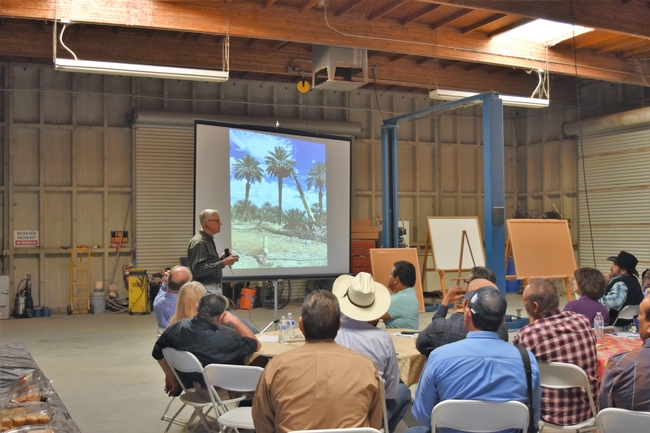
Robert Krueger, Citrus and date researcher Riverside USDA/ARS spoke about nitrogen assessment of date palms. He discussed diagnostic sampling implications, which suggest that there are differences in concentrations of various elements that occur in different portions of the leaf, and at different aged leaves can show different results, and also different seasons may also effect results. Based on the research it is suggested that the best sampling strategy is near khalal stage from middle pinnae of intermediate aged leaves during the summer.
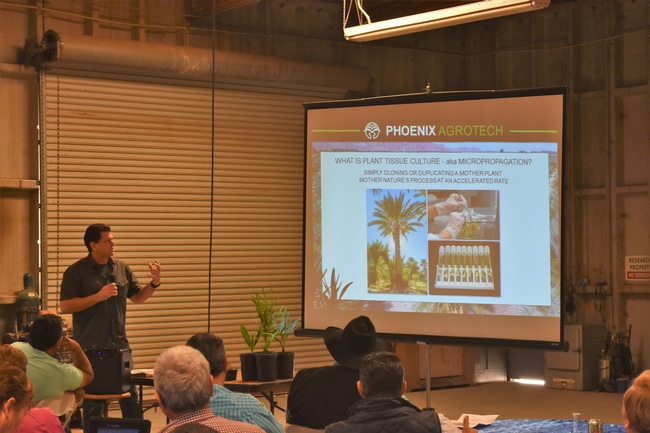
Peggy Mauk, UCCE-UCR Subtropical Horticulture Specialist spoke about establishment of date palms: Tissue Culture vs Off-shoots.
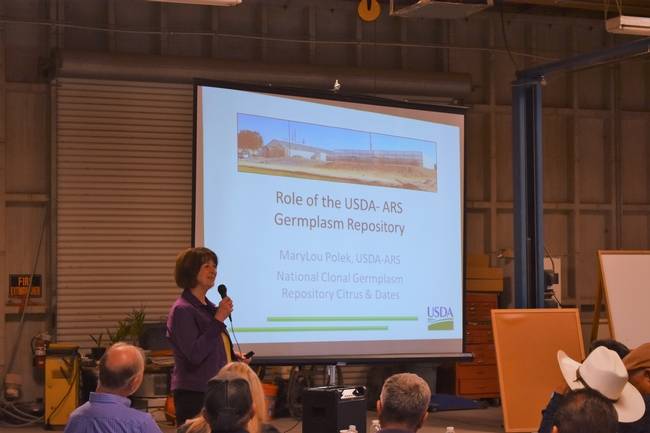
Sonia Rios, UCCE Riverside/San Diego Counties Subtropical Horticulture Farm Advisor spoke about pest issues in date palm, more specifically about weevils . Date palms flourish in high summer temperatures and low humidity which creates a perfect breeding ground and living conditions for pest, especially for the Red palm weevil (Rhynchophorus ferrugineus) (RPW) and South American palm weevil (Rhynchophorus palmarum) (SAPW). The RPW is considered most destructive arthropod pest of palms world-wide. SAPW causes similar damage on smaller scale. Both larvae's can cause economic damage as they feed on palm near apical growing point causing damage, which weakness the tree, and eventually causes death. The SAPW has been eradicated, however the RPW has been slowly showing up in date species in California, threatening the date industry. (Weevil Photos: Mark Hoddle)
The California date industry is worth ~$68 million (NASS, 2015). In 2015, 43,600 tons of dates where harvested. Coachella Valley produces about 95% of the dates consumed in the US. Date palms flourish in high summer temperatures and low humidity climates, which permits their production to certain growing regions. There are many threats to this economically important commodity and the University of California Cooperative Extension and other agencies are committed to assure the date industry thrives locally and globally. The planning committee looks forward to next year's event.
Date Palm Field Day
Date Palms were planted in the Coachella Valley of California, which is approximately two hours east of Los Angeles in the early 1890s. And now, plantings cover over 6,500 plus acres. These acres produce over 40 million pounds of our four primary varieties, which are the Deglet-Noor, the Medjool, the Barhi and the Zahidi.Date palms need plenty of ground water to drink, but high heat and arid weather to produce fruit. Therefore, date palms grow best in hot and arid climates.
Come learn about our date industry in California at the 2017 Date Palm Field Day
Time: 8:00 A.M – 3:00 P.M
Location: Coachella Valley Agricultural Research Station 86501 72nd Ave, Thermal, CA 92274
$15.00/person
Registration link coming soon
(Online registration available on site day of for walk-ins – payment by Card only)
Agenda
8:00 Registration
8:20 Welcome – Sonia Rios, CE Advisor
8:30 Tom Perring, UCR - Pink Hibiscus Mealybug biocontrol
9:00 Robert Krueger, USDA/ARS - Nitrogen assessment of date palms
9:30 Tony Fortier, Phoenix Agrotech - Tissue Culture date palms
10:00 Break
10:15 Peggy Mauk, UCR/CE - Establishment of date palms-Tissue Culture vs Off-shoots
10:45 MaryLou Polek, USDA/ARS - Role of the USDA Germplasm Repository
11:15 TBD
11:45 Lunch
(Included in registration)
1:30 Field tours
If you have any questions contact: Sonia Rios, UC Farm advisor
sirios@ucanr.edu
951.683.6491 Ext. 224

